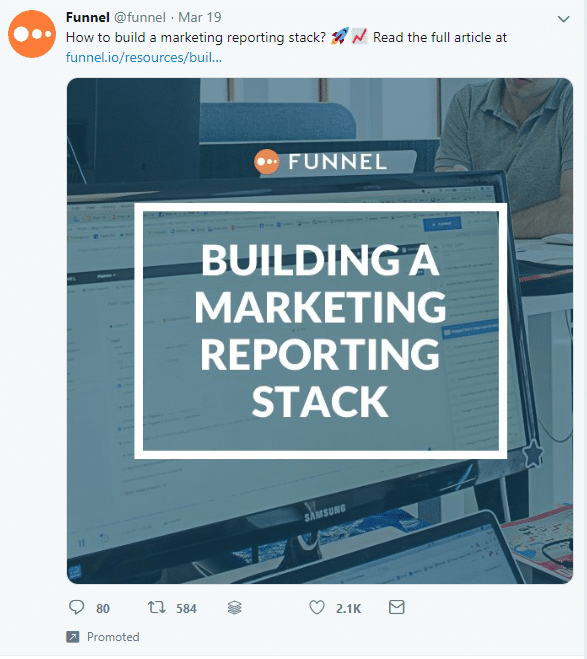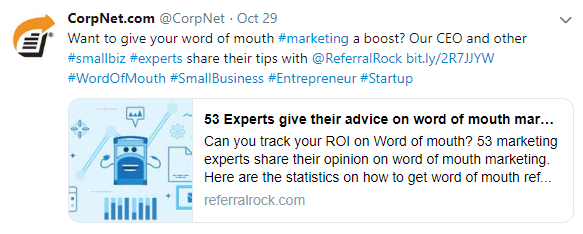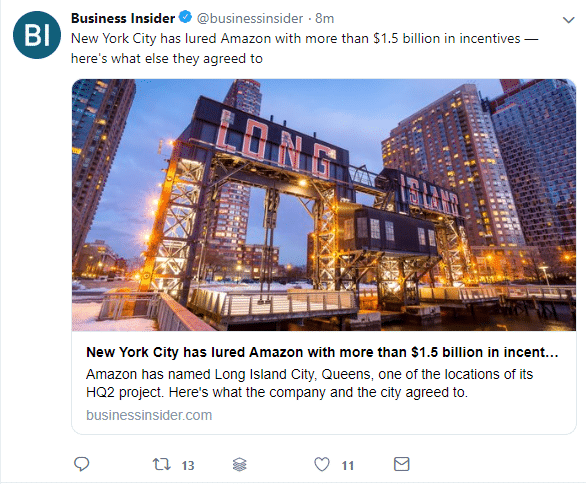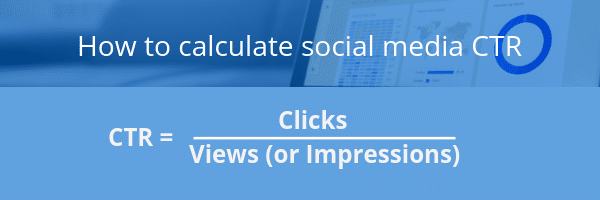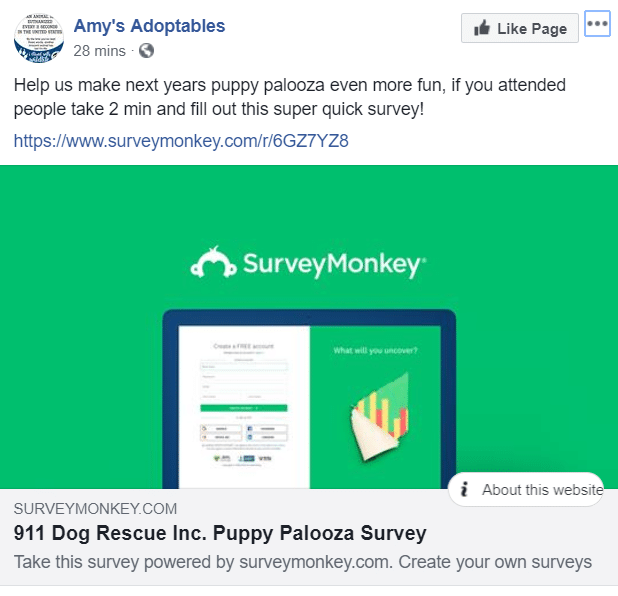Social media is short attention span marketing. It fits well with the attention span of today. If you’re a marketer, you probably realize you have just a few seconds to grab someone’s attention.
Many people use your business’ social media profile as a way to gauge how involved you are with customers. A Facebook or Twitter page with current posts, comments, and reviews can be a deciding factor for some potential leads.
Social media feeds can be busy, but you still need to participate. If you’re not part of the noise, do you even exist?
Why is social media so important for your business?
We all know marketing is the process of communicating value to customers. Social media is a tool or channel for marketing and aids in helping brands build their visibility and social currency.
Social networks aren’t just about you connecting with your customers, but also it allows them to connect with you. In fact, 73.4% of users will follow a brand because of their interest in the product or service. To further reiterate why social media is so important for your business, let’s take a look at these points:
Social media increases your brand awareness
By having a social site, you have essentially increased your channels to share and syndicate your content. This means you have the opportunity to not only share but to be shared too. You might even go viral. While virality is unpredictable, follow the tips in this viral marketing article to increase the odds that your content will go viral. And even if you don’t spark virality, you have still made it easier for people to talk about you.
It only takes one customer to share your content or your page to get leads. With that share, a whole new group of people has the chance of stumbling upon your name while scrolling through a feed.
Plus, social media makes you much more accessible. Even if you have a website and can be searched, your social networks make it that much easier for customers to find you.
Think of it like this, a social site is like an extension of you. For example, if someone searches for your business by name or product, you might pop up in a variety of searches whether it be your website or your Facebook page. Your social media pages help you take control of more top-ranking slots when people search for your brand name, making it easier for people to recognize you and thus building your brand awareness.
Social media enhances your SEO rankings
Social media can help you increase your content’s visibility in search results. Essentially, it provides a second home for your content – and makes that content incredibly easy to share.
That increased shareability means you are increasing your chances of creating quality backlinks. This is because your content is much easier to find.
Be sure you are using your social profiles to your full advantage. Hashtags, optimizing your profiles, and creating catchy headlines/tweets can make your engagement skyrocket and boost your SEO. And since your content gets found more quickly, your brand awareness is bound to increase even further.
Social media makes it easy to engage with customers
Social media is a tool that you can use to communicate directly with customers. You can publicly communicate by commenting, or you can even reach out privately.
Most of the time this works in your favor. Because customers are already on these sites, sometimes multiple times a day, they are more likely to share their good and bad experiences with your business here. This gives you the perfect opportunity to respond accordingly.
If a customer says something negative about your business, you have the ability to get in contact with the customer right away. Plus, you can use this as an opportunity to publicly apologize and move forward. Though this is a public setting, this interaction is personalized and can help strengthen that customer’s trust in you. Plus, the public will appreciate your willingness to own up and improve.
Though you may prefer receiving reviews on your review profiles, customers aren’t always on them. They also might not want to always sign up for a new profile. If you turn on your reviews on your social sites, you are essentially creating a convenient space (where customers already spend a lot of time) to write reviews and to engage with you.
Social sharing buttons make it even easier to share
You can also engage with customers by sharing their user-generated content. For example, someone may publicly talk about you on Twitter. You can easily retweet what they said and use that to increase your brand authority and trust. Your audience trusts what customers have to say about your brand much more than they trust the content that your brand shares directly. So, make sure to use user-generated content to your advantage!
If you’re actively sharing and commenting on these types of posts, customers will also want to be more engaged. Meaning they may continue to share your content or their experience with your brand to their followers.
This will increase your chances of being seen by potential leads too. Whether it be a quick search or a friend of your customer simply browsing through their feed. About “63% of consumers who search for businesses online are more likely to use ones with an informative social media presence,” according to Growth Gurus.
So if you’re actively engaging on your social site, you have a better chance of being chosen than a competitor who is not active on social media.
Social media is very cost-effective
Social profiles are free. So you can essentially build an empire with a free profile. And, if you’re like most businesses, you may pay to promote a post or two. Or you may even run an ad. But you don’t have to. This is why social media is important for businesses. It allows you the flexibility to pay as much or as little as you like while allowing you to have all the functions of a business page.
Though ads, even social media ads can be expensive you have the flexibility to choose how much you spend, how long your ad runs, and you can even choose which audience it gets sent out to.
Really the only cost you might incur is your time. Luckily, you probably won’t even have to spend too much time on it. According to Hubspot, 84% of marketers found as little as six hours of work on their social sites per week was enough to generate increased traffic. And, compared to traditional advertising or marketing campaigns, you’re likely to save a bit of money.
Does social media increase sales?
Social media and social media advertising rely heavily on word of mouth marketing. Essentially you are sharing your business, content, and expertise, and getting people to talk about you because of your need for social currency.
When someone tags or mentions your business in a comment, you become a trusted recommendation to their friends. Plus, you’re likely to be put in front of quality leads this way. Therefore, increasing your leads and referrals, and potentially increasing your sales all over the globe.
Social media does have the potential to increase your sales, even while being a cost-effective channel!
Social media is a paid, owned, and earned media channel – all at once
It’s uncommon for marketers to rely on just one media channel. Unlike most options, your social profiles can fall into all channels, paid, owned, and earned media. In many instances, you’ll see a brand hit on all three of these types of media with one single post.
For example, a brand will publish an article on their blog (owned channel). They will promote that article on Facebook (paid channel). Then you will see people sharing that post or article (earned channel).
Social media is a paid channel because of social media ads, which have become really popular. The ads themselves tend to blend in with the content around them and look like the rest of the feed around them (until you see the tiny ‘promoted’ stamped on it). Paid social media ads and boosted content give you leverage to choose what you want to spend and how long you want the ads to run. Influencer marketing can also be considered a paid use of social media since you compensate the influencers for promoting your brand.
Social media is an owned channel as well. It’s true that you don’t own the platform, but you do own your own little slice of real estate on it. Thus, your profile is considered owned media. It’s a free channel that you can use to talk about yourself, and share what’s going on with your company. You can really post whatever it is your heart desires, and in return, you can build your word of mouth.
Finally, social media is an earned channel. As we mentioned, social media is a platform for you to share your content. On the flip side, this is also where you’ll see people talking about you and sharing your content. Because social media channels are so versatile and rely on communication, it’s a great channel for word of mouth to occur. Notice how Business Insider shared an article and within just eight minutes, they have been retweeted and liked by a handful of people.
Social media statistics that prove it matters
By now you realize how vital of a role a social profile will have for your business. But, if you’re still not convinced, here’s a few social media statistics that prove it.
You’re bound to find a ton of your customers are active on social
Studies by Hootsuite found that 11 people join social media every second, and that there are now over 3.5 billion people using social media.
Maybe you have some customers who aren’t internet savvy, but you have a solid chance of finding a good handful who are.
49% of small businesses use social media for their digital marketing strategies
Keap found that 49% of small business marketers use social media management in their arsenal of digital marketing strategies. This number is sure to keep growing as the rate of social media use continues to grow.
Engaging with customers of social media builds loyalty
Social Media Today found that customers spend 20–40% more on brands who engage directly with them on social media.
Do a little bit of engaging and see how it affects your customers. You’ll likely find they are happy you are listening to them. This tiny act can turn a person into a true ambassador, as we’ll cover in the next tip.
When you pay attention to your customers on social, they will become true advocates
Statistics presented by Lyfe Marketing state 71% of consumers who have had a positive experience with a brand on social media are likely to recommend the brand to their friends and family.
This means that social media also plays a huge role in your customer service and the likelihood of getting referral leads. Want to know more about how social media and referral marketing work together?
Instagram can get you in front of a ton of new eyes
Hootsuite found that one billion people use Instagram every month, that 500 million of these users engage with Instagram Stories daily, and that 200 million of these users visit at least one business profile each day.
More and more users join social media sites every day. Meaning you have a ton of potential opportunities to be seen.
Be sure to monitor social media engagement
Social media is well worth it, but how will you know if your efforts are successful? You’ll need to monitor your engagement. If you’re not tracking your efforts, you’ll never know if your hard work, time, and money are paying off.
If you truly want to evolve your social media marketing and take advantage of having your face in front of a huge database that you can trim down to your target market, the tracking metrics is a must. As it will allow you the knowledge to tweak as you need, to see what is and isn’t working.
Social media metrics that matter
There a few metrics you should consider when tracking social media engagement. Here are a few of the most predominant things brands measure.
- Likes: One of the simplest metrics you can see are likes. Practically all social media platforms allow users to ‘like’ or ‘upvote’ a specific post. Youtube, Facebook, Twitter, etc. all have this feature and make immediately evident if what you’re posting works for your followers.
- Shares: To bump it up a notch from likes, you can measure how many shares a specific post gets. A share usually means someone likes or trusts your post so much that they are willing to share it with their friends.
- Growth rate: It’s important to pay attention to the rate of followers you’re obtaining. If you see a sudden drop of followers or a slower rate than usual, it might mean you need to do a bit of digging and make a few changes. Whether it be a change in the content you share or even when you share it.
- Your follower ratio: Sometimes a mixed-matched follow to following rate can deter people from liking you. Even though it’s important to follow other pages and businesses, you need to slow your role if your follow rate far exceeds your number of followers. You may come off as spammy or illegitimate especially if your number of followers is very low, while the number of people you follow is high.
- Clicks: You may get good engagement through clicks. This is a measurement of the number of times a link you shared was clicked. If you have a good amount of clicks it can be a sign that the content you share aligns well with your audience.
Social media tools
Your social pages will have built-in analytics and insights. Usually, these metrics include page views, page likes, and reach, along with a few other summaries.
But, if you want to get even more in-depth metrics, there are many social media tools that will allow you to take a deep dive into your social media analytics.
These types of tools allow you to measure your performance to help you learn how to take your marketing strategy to the next level.
Social media analytics tools include
- Followerwonk: This one is aimed towards Twitter and offers a free version for you to start analyzing your Twitter profile easily. It provides you with an overview of your followers and their actions. You can also see when your followers are likely to be online, to help you plan the perfect posting schedule for maximum engagement.
- Google Analytics: So this one is huge, and it’s a great analysis tool. Many businesses use it to track website traffic, but if you drill into it far enough you can get social metrics too. For example, you can determine how much traffic to your site comes from your social networks.
- Klear: Klear offers quite a few free tools (as well as paid versions), all of which focus on helping you find your influencers on your social sites. Klear ignores fake and bot followers so that you can focus on your real metrics. You can even view your follower’s interests to help you plan exactly what to share.
- SocialRank: The tool lets you easily identify, organize and manage your Instagram and Twitter followers. It also allows you to filter and sort your followers to further help you take the appropriate action in increasing your engagement.
- Social Champ: Is a great tool for helping drive traffic, increasing engagement and overall for saving time on social media. It’s a management tool that does everything from scheduling posts to analyzing performance.
How to calculate social media click-through rate
Calculating your social media click-through rate is vital in knowing how well your brand’s visibility is online especially when talking about ads. Your impressions are simply the number of page views. To figure out if you’re posts and ads are successful, you need to calculate the click-through rate.
You can do this by taking the volume of clicks and the number of views or impressions your page has and doing a simple math equation.
The ratio from your clicks and views is your click-through rate (CTR)
If you’re unsure of where to find these measurements your social profiles will give you this information (if you’re running ads). You’ll also be able to see this information from the analytic tools listed in the previous section.
Engagement rate formula
Depending on the platform you are using, you’ll have to modify your calculations. Here are formulas to determine Facebook and Twitter engagement rates.
Facebook: To find the engagement rate of a particular post on Facebook you’ll have to do a little math. No worries, it’s quite simple. You are basically taking the number of engaged users and dividing that number by the total reach of the post. Then multiplying that number by 100 to get a percentage.
Twitter: Similar to the formula above, Twitter uses the same idea but slightly different formula. You’ll be using your total likes and comments, dividing that by your number of followers and finally multiplying that by 100.
How to increase social media engagement
But now that you know how to measure social media engagement, how do you increase your engagement? As you’ll see there are a variety of ways to do it, and most of them are free.
Though you’ll find that a paid route may be beneficial in some scenarios, like advertising a new e-course or even promoting a specific new post or guide. Here are a few ideas:
1. Ask your followers questions
Most people enjoy the interaction of a quick Q&A. You can ask for their opinion on anything, whether it’s something that affects them or something more internal.
For example, you can get the customer to get to know you by asking their opinion on an in-office tie-breaker. This makes them feel like they’re on the inside and have contributed to your business. “Our team can’t decide on a Holiday Party theme, we need your help! Do you think ‘A Western Holiday’ or ‘Winter Wonderland’ would be more fun?” Then of course mention, you will provide photos of the event.
Even if the questions aren’t about your product or your customers, they should be fun and something people will participate.
Additionally, you can engage with customers on other social sites like Reddit and Quora, and share those posts on your other social profiles.
Here are a few ways to build engagement via questions.
Polls: The example used above would fit into this category nicely. You can create a poll about anything. Whether it be a product question, a fun question, or a serious debate. Polls are great because they are interactive, but they aren’t too much work. You get answers and results quickly, and it takes hardly any effort for a customer to choose.
Twitter polls have been pretty popular, and you may have engaged with one yourself. If you look at a lot of today’s top brands, they use Twitter polls as a fast way to engage with customers whether it be purely for fun or insight.
Surveys: You may have seen your fair share of surveys floating around the web. You’re probably also familiar with the ones that pop up every once in a while on your Facebook feed. These pop up because your friends and connections often engage with these types of surveys. They post their answer and others decide to join in on the fun.
As a brand, you can use this same idea. Even though most of these types of surveys are just for fun, you can use the concept to better engage with your customers. Even if you are trying to ask serious questions to gain real data, you can make it fun or intrigue people to answer by giving them a coupon code for completing the survey.
2. Use images and videos
Social may be a channel for communication, but it relies a lot on visuals. Most people will scroll through their newsfeeds and pause briefly to check out something that looks appealing. You can achieve this with a good social media template!
So by including an image in your post, you are increasing your chances of providing some interesting visual stimulation. Plus, it can help you provide insight into what you’re talking about. You’ve heard ‘an image is worth 1000 words’, and in this case it is true.
Research has found that images can result in up to an 85% interaction rate on Facebook and increased retweets by 35%.
Some image ideas include:
- Infographics
- Photos of behind the scenes
- Memes
- Sneak peeks of new products
- Original, unique photos
As you engage your customers with images and videos, you may find they’re also willing to do the same with you. For instance, with home insurance and social media, the photos customers post and are willing to share with agents can have an impact on the claims process – for better or worse. It’s the kind of engagement that can ultimately open the doors for business to have increased, and more beneficial, communication.
3. Start a giveaway
Everyone loves a giveaway, especially if what you’re offering is something they like. Instagram and Facebook have taken giveaways to a whole new level.
One you may have seen a lot of lately are chains of businesses coming together to offer one mega gift or multiple gifts. For example, you may follow a brand on Instagram. That brand may host a giveaway with a couple of other similar brands. They want you to re-post their image, use a specific hashtag, and follow all the other brands in the giveaway. They may team up to give one lucky winner a mega basket of gifts, or they may each draw a different individual to reward with a prize after that person has completed all their steps.
Or the more simple version of retweeting or reposting a specific image and using the requested hashtag. Sometimes, these simple ones can bring in extra leads by requesting followers to also tag a friend.
Regardless of which route you choose to do your giveaway, you’ll likely see a ton of new engagement. And will likely get a ton of new followers because of it, providing increased exposure for your brand.
Tip: You can gain extra followers by including your profile link in your regular email blasts and promoting it on your blog. If you mention the giveaway on top of that, it might intrigue people to follow and like your page!
4. Make people laugh
Everyone loves a little bit of humor. And when you get people’s emotions going, you can facilitate engagement. This is partly why memes spread like wildfire. This is also the reason why brands like Wendy’s has done well on social media. They have found a way to make their responses and updates sarcastic and funny.
You don’t just have to be sarcastic to be fun or funny though. You can offer something fun or ask for people to participate in something fun.
Many brands have been asking their customers to “caption this”, or respond with an emoji. These are effortless tactics to get people to participate. This can further increase your engagement and loyalty.
Check out your local businesses Facebook or Twitter. You may find that some of them offer freebies for your participation. For example, this Chick-fil-A asked it’s customers to caption their image.
As you can see they added a bonus, a free chicken sandwich, making the ‘task’ even more fun.
5. Share the facts
Most people try to share things that make them look good, funny, and smart. If you share statistics or pull a statistic from your article and use it as the caption of your post, it’ll probably be shared. Statistics are great fuel for sharing.
By doing this, you’re also paving way for your name or brand to be an authority in your niche. The more knowledge you share, the more believable and trustworthy you’ll appear in the market.
All of which are great attributes for sharing. Not only just for sharing either. With an increase in sharing, you’ll likely see a higher engagement rate for your content too. However, Maria Meijer, a content manager at GrabMyEssay, adds, “An important factor here is the quality of the content your brand will share. It should be based on facts, your own professional experience and the experts` opinions. At the same time, provide clear instruction on how this information can be applied to real-life cases.”
Other simple things to try to increase your engagement
We’ve mentioned quite a lot already on how to increase your engagement on social media. But, really the list can go on and on. Here are a few more of our favorites.
- Post videos or do live video shares: Video content is huge. Videos have a way of intriguing customers to stop and watch. As we have mentioned visuals make an excellent medium for sharing and increase interaction.
- Talk about your niche, not just your brand: No one wants to land on your profile to read a lot of sales-y content. Most of the time, people are simply looking for information in your niche. And if they are interested, they will look into your brand further by visiting your website. If you can provide general information, and establish yourself as a thought-leader, you’ll be easier to engage with.
- Share content other than your own: Again, it’s not always about you. If you share other content, you may find that others are likely to share your content too. You should realize that a partner business may have the answer to a question that you aren’t as well-versed in. This is also a good way to build backlinks.
Summary
As you can see, when done right, social media marketing can be a wonderful thing for your business. It will help you increase your brand authority, brand trustworthiness, and it will even help you engage with customers.
You also see that increasing your customer interactions and engagement with social media isn’t really that difficult to do. But the effort you do put in can have a major pay off. Just be sure to monitor your efforts, so that you can track what is and isn’t working for you.

